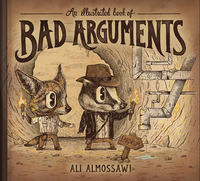Take a photo of a barcode or cover
funny
informative
lighthearted
medium-paced
Looks beautiful but doesn't quite work. The images don't really help the explanations and the explanations themselves aren't quite fleshed out enough. A nice idea though.
While the book is geared toward those new to logical arguments, it can also be used as a quick reference by those who are familiar with arguing but forget the names of logical fallacies or struggle with explaining them.
Read more reviews at my site https://blog.digitalamrit.com
I happened to see Ali Almossawi's AMA about his new book on Reddit. It seemed interesting and so I explored the author's book further. I started reading his first book - this one. The premise showed promise - An illustrated book to explain logical fallacies to newbies. It is a short read - about 15 minutes.
But, I am disappointed. The illustrations are not explanatory - rather they give an example while looking whimsical. The accompanying text is also nothing special. The content in this book is available for free on the author's website - http://almossawi.com/bookofbadarguments.html and also for sale on amazon. It is definitely not worth your money. I am not getting into what will make this book better as there is so much that is missing or not done properly.
Just for reference, I have linked the fallacies page from wikipedia. I think it does a much better job of explaining the fallacies.
I happened to see Ali Almossawi's AMA about his new book on Reddit. It seemed interesting and so I explored the author's book further. I started reading his first book - this one. The premise showed promise - An illustrated book to explain logical fallacies to newbies. It is a short read - about 15 minutes.
But, I am disappointed. The illustrations are not explanatory - rather they give an example while looking whimsical. The accompanying text is also nothing special. The content in this book is available for free on the author's website - http://almossawi.com/bookofbadarguments.html and also for sale on amazon. It is definitely not worth your money. I am not getting into what will make this book better as there is so much that is missing or not done properly.
Just for reference, I have linked the fallacies page from wikipedia. I think it does a much better job of explaining the fallacies.
"The first principle is that you must not fool yourself and you are the easiest person to fool."
-- Richard P Feynman

I bought this book shortly after I bought Randall Munroe's [b:Thing Explainer: Complicated Stuff in Simple Words|25329850|Thing Explainer Complicated Stuff in Simple Words|Randall Munroe|https://d.gr-assets.com/books/1431518396s/25329850.jpg|45065096] and [b:What If?: Serious Scientific Answers to Absurd Hypothetical Questions|21413662|What If? Serious Scientific Answers to Absurd Hypothetical Questions|Randall Munroe|https://d.gr-assets.com/books/1451351509s/21413662.jpg|40714465] and at the same time I purchased Joyce's [b:The Cats of Copenhagen|15767100|The Cats of Copenhagen|James Joyce|https://d.gr-assets.com/books/1343084295s/15767100.jpg|19158060]. So, I guess I was going through a nerd graphic need for pictures with my words.
I've always liked logic, books on logical fallacies, debate, and rhetoric. I figured this might be an interesting book to get for my kids. What isn't to like? Logic presented by anthropomorphized squirrels and badgers? Sign me up. The problem is, however, the book was aiming for a couple different audiences and missed them all.
Is this a primer on logic? I'm not sure if the way it is laid out and introduced will prime my kids to either be: a) interested in logic or b) better at logic. The book itself suggests this is their primary audience on page 1 under the title: Who is this book for? "This book is aimed at newcomers to the field of logical reasoning, particularly those who, to borrow a phrase from Pascal, are so made that they understand best through visuals."
Is this aimed (unofficially) at those who love logic and are searching for a coffee table book or nontraditional text? Well, I can't speak for the whole universe of logic lovers, but in my case I found BOTH the words and drawings a bit too messy and almost incoherent. Ugh. The author claims in the Preface that he wanted to create, unlike Lewis Carroll and George Orwell, a "narrative that ties the illustrations together". There just seemed to be a larger void between the wish and the execution with this book. I applaud the attempt, but perhaps, the idea required a bit more thought. I don't think the author was misinformed about logic or illustration's ability to aid in education, but it just seemed to me that, either because of brevity or arrangement the idea didn't work.
Is this aimed at those who love picture books? Perhaps, but again, as I pointed out above BOTH the pictures and the text were a bit of a disappointment.
Probably the only piece of this whole thing I enjoyed without reserve was the drawing of the logical family tree which showed how logical fallacies broke down into formal and informal fallacies, etc. But this part should have provided hints that some internal book logic was missing. This graphic appeared near the beginning of the book, but the arrangement of chapters for the 19 examples of bad arguments didn't fit the graphic and the table of contents was several pages earlier. Talk about missing an easy hit.
Finally, it was a bit irritating to have the author describe the book's illustrations as "memorable" and "lively". I get that the author is, perhaps, tipping his hat to his illustrator (Alejandro Giraldo), but still, I'll be the judge of how lively and memorable the illustrations are OR book is thank you very much.
Looking back on casual purchase of introductory books about logic, I guess I just prefer jokes with my logic instead of visuals with my logic (see: [b:Plato and a Platypus / Aristotle and an Aardvark|6050142|Plato and a Platypus / Aristotle and an Aardvark Boxed Set|Thomas Cathcart|https://d.gr-assets.com/books/1328813104s/6050142.jpg|6225778]).
Now that I think of it, this book seems to be more interesting as an example of modern book marketing (slick website, an affinity for number of web visitors, donations, metrics, etc). Anyway, don't take my word for it. You don't even need to buy it (or hell, go ahead and buy it I don't care), just go to the book's website.
Oh, and here is the real rub. I was irritated enough with the whole book I actually went through the process of returning it to Amazon. They asked why, I gave them a quick answer. They refunded my money and said, "PLEASE DON'T SEND IT BACK". I know they were just being logical in an economic sense. The $10 I paid for it after prime shipping it to me, made it basically more economical to just give me my money back rather than shipping it out again. Again, that was logical, but part of me just FELT like even they didn't want it.
-- Richard P Feynman

I bought this book shortly after I bought Randall Munroe's [b:Thing Explainer: Complicated Stuff in Simple Words|25329850|Thing Explainer Complicated Stuff in Simple Words|Randall Munroe|https://d.gr-assets.com/books/1431518396s/25329850.jpg|45065096] and [b:What If?: Serious Scientific Answers to Absurd Hypothetical Questions|21413662|What If? Serious Scientific Answers to Absurd Hypothetical Questions|Randall Munroe|https://d.gr-assets.com/books/1451351509s/21413662.jpg|40714465] and at the same time I purchased Joyce's [b:The Cats of Copenhagen|15767100|The Cats of Copenhagen|James Joyce|https://d.gr-assets.com/books/1343084295s/15767100.jpg|19158060]. So, I guess I was going through a nerd graphic need for pictures with my words.
I've always liked logic, books on logical fallacies, debate, and rhetoric. I figured this might be an interesting book to get for my kids. What isn't to like? Logic presented by anthropomorphized squirrels and badgers? Sign me up. The problem is, however, the book was aiming for a couple different audiences and missed them all.
Is this a primer on logic? I'm not sure if the way it is laid out and introduced will prime my kids to either be: a) interested in logic or b) better at logic. The book itself suggests this is their primary audience on page 1 under the title: Who is this book for? "This book is aimed at newcomers to the field of logical reasoning, particularly those who, to borrow a phrase from Pascal, are so made that they understand best through visuals."
Is this aimed (unofficially) at those who love logic and are searching for a coffee table book or nontraditional text? Well, I can't speak for the whole universe of logic lovers, but in my case I found BOTH the words and drawings a bit too messy and almost incoherent. Ugh. The author claims in the Preface that he wanted to create, unlike Lewis Carroll and George Orwell, a "narrative that ties the illustrations together". There just seemed to be a larger void between the wish and the execution with this book. I applaud the attempt, but perhaps, the idea required a bit more thought. I don't think the author was misinformed about logic or illustration's ability to aid in education, but it just seemed to me that, either because of brevity or arrangement the idea didn't work.
Is this aimed at those who love picture books? Perhaps, but again, as I pointed out above BOTH the pictures and the text were a bit of a disappointment.
Probably the only piece of this whole thing I enjoyed without reserve was the drawing of the logical family tree which showed how logical fallacies broke down into formal and informal fallacies, etc. But this part should have provided hints that some internal book logic was missing. This graphic appeared near the beginning of the book, but the arrangement of chapters for the 19 examples of bad arguments didn't fit the graphic and the table of contents was several pages earlier. Talk about missing an easy hit.
Finally, it was a bit irritating to have the author describe the book's illustrations as "memorable" and "lively". I get that the author is, perhaps, tipping his hat to his illustrator (Alejandro Giraldo), but still, I'll be the judge of how lively and memorable the illustrations are OR book is thank you very much.
Looking back on casual purchase of introductory books about logic, I guess I just prefer jokes with my logic instead of visuals with my logic (see: [b:Plato and a Platypus / Aristotle and an Aardvark|6050142|Plato and a Platypus / Aristotle and an Aardvark Boxed Set|Thomas Cathcart|https://d.gr-assets.com/books/1328813104s/6050142.jpg|6225778]).
Now that I think of it, this book seems to be more interesting as an example of modern book marketing (slick website, an affinity for number of web visitors, donations, metrics, etc). Anyway, don't take my word for it. You don't even need to buy it (or hell, go ahead and buy it I don't care), just go to the book's website.
Oh, and here is the real rub. I was irritated enough with the whole book I actually went through the process of returning it to Amazon. They asked why, I gave them a quick answer. They refunded my money and said, "PLEASE DON'T SEND IT BACK". I know they were just being logical in an economic sense. The $10 I paid for it after prime shipping it to me, made it basically more economical to just give me my money back rather than shipping it out again. Again, that was logical, but part of me just FELT like even they didn't want it.
Despite the billing as a visual resource, I found the illustrations difficult to parse, especially if I look at them before reading the full description of each argument. Not terribly more accessible to me than the Wikipedia series on logical fallacies.
The text was fine, but I didn't feel the illustrations were helpful. In many cases they were more confusing than the text.
A book I'll enjoy referring to now and then, if only to remind myself not to fall down the slippery slope of logical fallacies.
Only slightly wordier review: http://jenn.booklikes.com/post/1249752/bookbadarguments
Only slightly wordier review: http://jenn.booklikes.com/post/1249752/bookbadarguments




